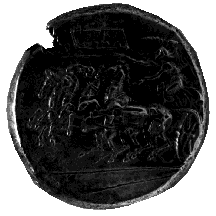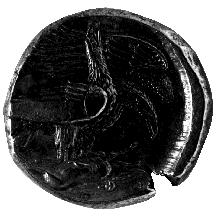



(8) Akragas, Sicily (Italy) - AR tetradrachm, 413-406 B.C., 17.42
g. (inv. 93.010).
Obverse: Racing quadriga l., driven by Nike; tablet above inscribed ![]() : of the Akragantines; club in
exergue.
: of the Akragantines; club in
exergue.
Reverse: Two eagles devouring hare r.
Provenance: Harlan Berk, 1989.
Bibliography: C.T. Seltman, "The engravers of the Akragantine decadrachms,"
Numismatic Chronicle 1948, 1-10.
Akragas, modern Agrigento, was founded c. 580 B.C. by settlers from the
Rhodian colony of Gela. It was one of the wealthiest cities of Sicily, prospering
from its agricultural exports to Carthage. It reached its period of greatest
influence under the tyrant Theron, 488-472 B.C., whose building program
included a colossal Temple of Olympian Zeus. The city was destroyed by Carthage
in 406 B.C.
The eagle, attribute of Zeus, was the most frequent Akragantine coin type.
It appeared as a simple standing bird on the obverse of the city's coins
until the late fifth century, when under the influence of the coins of Syracuse
it was displaced by a victorious quadriga (see nos. 16,
17, 18, 19).
On the reverses of these coins the tame standing bird of earlier issues
was replaced by two mighty eagles devouring a hare. Both eagles stand on
their prey, one with spread wings about to pick at the animal, the other
raising its head to swallow or scream.
The quadriga on the obverse may originally have referred to an Olympic victory,
but it was used for several years. Like its Syracusan model, it is a fast-moving
quadriga with spirited horses throwing their heads into the air; one die
shows a broken rein trailing on the ground.
C.L.L.



All contents copyright (c) 1996.
Lawrence University
All rights reserved.